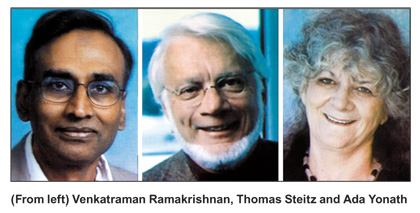
AMERICANS Venkatraman Ramakrishnan and Thomas Steitz and Israeli Ada Yonath won the 2009 Nobel Prize in chemistry yesterday for atom-by-atom mapping of the protein-making factories within cells.
The Royal Swedish Academy of Sciences said their work on ribosomes has been fundamental to the scientific understanding of life and has helped researchers develop antibiotics.
Yonath, 70, is the fourth woman to win the Nobel chemistry prize and the first since 1964, when Dorothy Crowfoot Hodgkin of Britain received the award.
“I’m really, really happy,” Yonath said. “I thought it was wonderful when the discovery came. It was a series of discoveries … We still don’t know every, everything, but we progressed a lot.”
The three laureates, who will share the 10 million kronor (US$1.4 million) award, generated three-dimensional models that show how different antibiotics bind to ribosomes.
“These models are now used by scientists in order to develop new antibiotics, directly assisting the saving of lives and decreasing humanity’s suffering,” the academy said.
The researchers used a method called X-ray crystallography to pinpoint the positions of the hundreds of thousands of atoms that make up the ribosome.
“This knowledge can be put to a practical and immediate use; many of today’s antibiotics cure various diseases by blocking the function of bacterial ribosomes,” the citation said. “Without functional ribosomes, bacteria cannot survive. This is why ribosomes are such an important target for new antibiotics.
Their work builds on the Charles Darwin’s theory of evolution and, more directly, on the work done by James Watson, Francis Crick and Maurice Wilkins who won the 1962 Nobel Prize in medicine for mapping DNA’s double helix, the citation said.
In 2006, Roger D. Kornberg won the Nobel Prize in chemistry for X-ray structures that showed how data are copied to messenger RNA molecules, which carry information from DNA to the ribosomes.
“Now, one of the last pieces of the puzzles has been added — understanding how proteins are made,” said professor Gunnar von Heijne of the academy, the chairman of the Nobel Committee for Chemistry. “This discovery is important not only for science as such, but also gives us tools to develop new antibiotics.”
Alfred Nobel, a Swedish industrialist who invented dynamite, established the Nobel Prizes in his will in 1895. The first awards were handed out six years later.
Each prize comes with a 10-million-kronor purse, a diploma, a gold medal and an invitation to the prize ceremony in Stockholm on December 10. The Peace Prize is handed out in Oslo, Norway.


